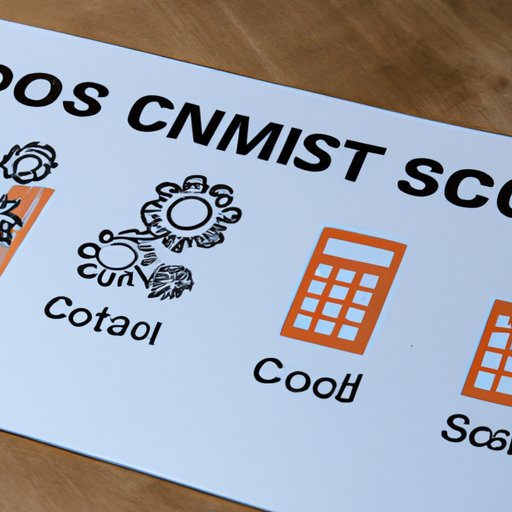
Introduction
Cost of goods sold (COGS) is an essential measure that calculates the expenses directly associated with producing products or providing services. In simpler words, it’s the amount you spent to acquire the materials and labor used to create what you sell. Knowing how to calculate and analyze your COGS can help you make informed decisions about pricing your products, managing inventory, and improving your profit margins.
This article is for small business owners, managers, and anyone who wants to understand how to calculate and utilize COGS in their business.
How to Calculate Cost of Goods Sold: A Beginner’s Guide
COGS is a crucial metric to calculate the true cost of producing or providing products or services. To calculate your COGS, you need to add up all the direct costs associated with creating the product or service.
The formula for calculating COGS is:
COGS = Beginning inventory + Inventory purchases – Ending inventory
To break it down further:
- Beginning inventory: The cost of the products or materials you had on hand at the beginning of the period you want to measure.
- Inventory purchases: The cost of the products or materials you purchased during the period you want to measure.
- Ending inventory: The cost of the products or materials you had on hand at the end of the period you want to measure.
Let’s take an example to illustrate how to calculate COGS:
Suppose you sell handmade bags, and the cost of materials for each bag is $20. During the period, you started with 50 bags in inventory ($20 x 50 = $1,000) and purchased materials worth $1,500 to make an additional 75 bags. At the end of the period, you had 20 bags worth $400 in inventory. To calculate your COGS:
COGS = Beginning inventory + Inventory purchases – Ending inventory
= $1,000 + $1,500 – $400
= $2,100
Your COGS for the period is $2,100, and you can use this figure to evaluate the profitability of your handmade bag business.
The Ultimate Guide to Determining Your Cost of Goods Sold
Calculating COGS using the formula is easy if you have all the data. However, determining COGS accurately can be complex. Here are some of the factors that can affect your COGS:
- Material costs: The cost of the raw materials used to make the products.
- Labor costs: The amount paid to employees or contractors to work on the products.
- Overhead costs: The expenses associated with running your business, such as rent, utilities, and insurance.
- Inventory valuation method: The method used to determine the value of the inventory, such as First-In, First-Out (FIFO), Last-In, First-Out (LIFO), or Weighted Average.
Choosing the right method to determine your COGS can affect your financial statements and tax obligations. To help you choose the best method for your business, here is a comparison of the three common methods:
First-In, First-Out (FIFO)
FIFO is the most commonly used method for determining COGS. It assumes that the first products bought or manufactured will be the first sold. This method is suitable for businesses that deal with perishable products or have a low turnover rate, as it avoids inventory spoilage or obsolescence.
Last-In, First-Out (LIFO)
LIFO assumes that the most recent products purchased or manufactured will be the first sold. It’s suitable for businesses that deal with non-perishable items that don’t expire or change in quality, as the older inventory remains unsold and is reported as an asset on the balance sheet. LIFO can be beneficial for tax purposes as it reduces taxable income by using more recent, higher-priced inventory costs.
Weighted Average
The weighted average method calculates COGS by averaging the cost of all inventory purchased or produced during the period. It’s particularly suitable for businesses with a high turnover of inventory and those dealing with homogenous products that can’t be easily distinguished by purchase date.
The method you choose depends on your business needs, accounting systems, and tax obligations. It’s essential to weigh the pros and cons of each method before deciding.

Accounting 101: Understanding The Cost of Goods Sold Equation
To calculate your COGS accurately, you need to know each component of the COGS equation:
COGS = Beginning inventory + Inventory purchases – Ending inventory
Beginning Inventory
The cost of the products or materials you had on hand at the beginning of the period you want to measure. It includes the cost of all finished goods, work-in-process goods, and raw materials you held in stock.
Inventory Purchases
The cost of all the products or materials you purchased during the period. It includes the original cost, freight charges, import duties, and any other additional costs incurred to bring the items into your inventory.
Ending Inventory
The total cost of all the products or materials you held in stock at the end of the period you want to measure. It includes the cost of all finished goods, work-in-process goods, and raw materials.
Examples to show how each component affects the cost of goods sold
Suppose you have a bakery business and calculate your COGS for the month of September 2021. The following are the scenarios:
- Scenario 1: No beginning inventory, no ending inventory
- You purchased $5,000 worth of flour, sugar, butter, and other baking materials during September.
- COGS = Beginning inventory + Inventory purchases – Ending inventory
- = $0 + $5,000 – $0
- = $5,000
- Scenario 2: Beginning inventory but no ending inventory
- You started the month with $1,000 worth of baking materials in inventory.
- You purchased $5,000 worth of baking materials during September.
- COGS = Beginning inventory + Inventory purchases – Ending inventory
- = $1,000 + $5,000 – $0
- = $6,000
- Scenario 3: Beginning inventory and ending inventory
- You started the month with $1,000 worth of baking materials in inventory.
- You purchased $5,000 worth of baking materials during September.
- You ended the month with $500 worth of baking materials in inventory.
- COGS = Beginning inventory + Inventory purchases – Ending inventory
- = $1,000 + $5,000 – $500
- = $5,500
Your COGS for September is $5,000.
Your COGS for September is $6,000.
Your COGS for September is $5,500.
Simplifying Cost of Goods Sold Calculations For Small Businesses
Small business owners may find it challenging to calculate COGS accurately, especially if they don’t have a dedicated accounting department. Here are some tips to simplify the calculation process:
Use Online Tools and Templates
Many online tools and templates are available that can help you calculate your COGS. These tools and templates can automatically track your inventory and calculate COGS for you.
Track Inventory in Real-Time
Real-time inventory tracking can help you keep track of inventory movement and ensure that your COGS calculations are accurate.
Separate Direct and Indirect Costs
Separating direct and indirect costs can help you determine your COGS accurately. Direct costs are the expenses incurred to produce the product or service, while indirect costs are general expenses that can’t be directly attributed to the product or service.
Outsource Your Accounting
Hiring professional accountants or outsourcing your accounting can ensure that your financial statements, including COGS, are accurate and up-to-date.
Using Software to Streamline Your Cost of Goods Sold Analysis
Manually calculating COGS can be time-consuming and prone to errors. Using software can help you streamline the calculation process and provide you with accurate and reliable data. Here’s how:
Automated Inventory Tracking
Inventory management software can automatically track your inventory levels and cost of goods sold by pulling data from your point of sale (POS) system.
Real-Time Data Analysis
COGS software can provide you with real-time data analysis, allowing you to make informed decisions about your inventory levels, pricing, and profit margins.
5 Common Mistakes to Avoid When Calculating Cost of Goods Sold
Calculating COGS involves many factors, and any mistake can affect your financial statements and profitability. Here are five common mistakes to avoid:
Not Including All Direct Costs
Be sure to include all direct costs, such as labor and materials, associated with producing the product or providing the service.
Not Tracking Inventory Accurately
Track your inventory in real-time and ensure that you account for all inventory transaction costs, such as shipping and handling fees.
Mixing Direct and Indirect Costs
Separating direct and indirect costs can help you calculate your COGS accurately. Mixing the two types of costs can make your financial statements unclear and difficult to analyze.
Using the Wrong Inventory Valuation Method
Choosing the wrong inventory valuation method can affect your financial statements and tax obligations. Choose the method that best suits your business needs and accounting systems.
Not Updating Your COGS Frequently
Keeping your COGS up-to-date is essential to make informed decisions about pricing, inventory management, and profitability. Don’t forget to update your COGS as often as necessary to ensure that your financial statements reflect the current state of your business.
How to Use Cost of Goods Sold Data to Make Strategic Business Decisions
COGS data can provide you with valuable insights into your business operations, profitability, and pricing strategy. Here are some ways to use COGS data to make strategic business decisions:
Set Competitive Prices
Knowing your COGS can help you set competitive prices that ensure you make a profit while remaining attractive to customers. You can analyze your competitors’ prices and adjust yours accordingly to maximize sales and revenue.
Reduce Operating Costs
COGS data can help you identify areas of your business that are driving up your costs. You can evaluate your suppliers, production process, and labor costs to identify ways to reduce your operating costs and increase your profit margins.
Optimize Inventory Management
COGS data can help you determine the optimal inventory levels required to meet customer demand without overstocking or understocking. You can analyze inventory turnover and reorder timing to ensure that your stock levels are optimal for your business.
Conclusion
Calculating your cost of goods sold is essential to managing your business operations and profitability. Use the tips and strategies discussed in this article to make informed decisions about pricing, inventory management, and reducing operating costs. By calculating your COGS accurately and frequently, you’ll have a better understanding of your business’ financial health, and you can make informed decisions accordingly.
Remember, keeping your COGS data updated and utilizing it to make strategic business decisions can significantly impact your business’s success.
Call-to-Action
Ready to take control of your COGS? Start by analyzing your business processes and accounting procedures. Implement the tips and strategies discussed above and stay updated on the latest accounting software and tools. You’ll soon realize the impact that accurate COGS data can have on your business.





